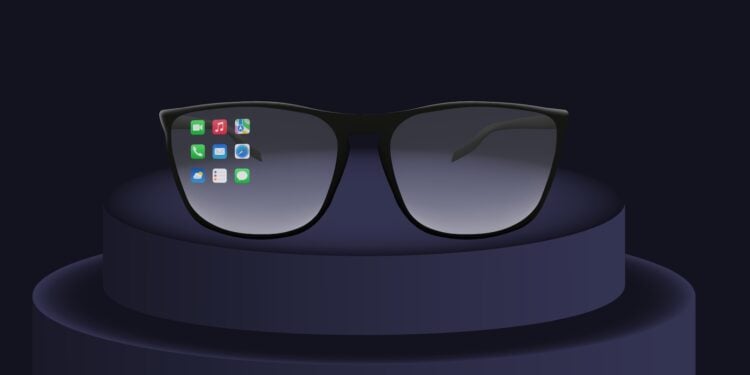Apple is working on its own smart glasses, which are likely to play a central role in the company's long-term product strategy. While the focus has so far been on the Vision Pro, Apple is apparently shifting its priorities to a lighter model – Apple Glass. The goal is to compete with Meta's new Ray-Ban glasses. According to current information, however, the first version of Apple Glasses will be released without an augmented reality display. Only the second generation is expected to feature an integrated AR system.
Since the launch of the Apple Vision Pro, it has been clear that Apple intends to expand its augmented reality offerings long-term. While the Vision Pro serves as a technological starting point, it is primarily aimed at developers and professional users. With Apple Glasses, Apple is apparently planning a lighter, more everyday product that is more geared towards a broader audience. The glasses are intended to be less of a high-end headset and more of an unobtrusive, always-wearable pair of smart glasses, similar in design and weight to regular glasses. Several reports, including one from Bloomberg, indicate that Apple could unveil this new generation of glasses in late 2026 and bring it to market sometime in 2027. This would mean the company following a similar approach to the launch of Apple Silicon: first an announcement, then time for developers to adapt their software before the product goes on sale.
First generation without AR display
According to current information, the first version of Apple Glasses will not have an AR display. This means that no digital content will be projected into the field of view, as is the case with the Vision Pro or some concepts from other manufacturers. Instead, Apple is likely to focus on basic smart functions in the first generation to create a stable foundation for later models. According to reports, Apple is working on a specially developed processor based on the Apple Silicon architecture. This chip will function similarly to the processor in the Apple Watch and be energy-efficient enough to fit into a small, lightweight frame. Planned functions include handling phone calls, using Siri, and the ability to take photos - all directly from the glasses. The first generation of Apple Glasses is therefore intended to support everyday life without crossing the boundaries of augmented reality.
Second generation with integrated AR system
Apple could use this to test how well such a product performs in daily use before introducing more complex AR features. The second generation of Apple Glass will, as things stand, be the first model to offer a true AR experience. While there are no concrete technical details or an exact release date yet, the evidence so far suggests that Apple could integrate the display directly into the lens. This integration would be a crucial step toward bringing augmented reality into an unobtrusive, everyday format. While current AR headsets like the Vision Pro still appear highly visible and technically complex, glasses with an integrated AR system would appear significantly more natural.
Why Apple is not the first, but often the best
This could make Apple the difference—a device that feels like regular glasses, but displays additional digital information. It's likely no coincidence that Apple is taking its time introducing this feature. The company has repeatedly demonstrated in the past that it prefers to wait until a technology is mature before integrating it into a mass product. The experience gained with the first generation also allows Apple to gather important data on user behavior and optimize software integration with other devices—such as the iPhone, Apple Watch, or Mac.
Apple's long-term plan for the smart glasses market
Apple appears to be pursuing a long-term plan with Apple Glass. The first version lays the foundation, the second brings the actual technological leap. While Meta is already gaining initial experience in everyday use with its Ray-Ban glasses, Apple is opting for a slower, more controlled development process. If the schedule holds, Apple Glasses will initially launch in 2027 as smart glasses without AR features. The successor model is likely to then take the decisive step toward augmented reality. Until then, it remains to be seen how far development has progressed and whether Apple can fully achieve its goal of building lightweight, powerful, and visually discreet AR glasses. The only thing that is certain is that with Apple Glasses, Apple will enter the smart glasses market – cautiously at first, but with the long-term goal of redefining the concept of augmented reality. (Image: Shutterstock / FrameStudio)
- Apple launches reorganization: New head of AI sought
- Apple Vision Pro: New Dual Knit Band for more comfort?
- Apple pursues rare strategy in launching smart glasses
- Apple plans AI smart glasses and stops Vision Air development
- iPhone Fold 2026: Apple's first foldable smartphone in detail
- Apple M5 chip leak reveals powerful GPU performance in the iPad Pro
- New Siri features could become reality with iOS 26.1
- Apple accelerates production of M5 Macs and displays
- Apple is testing LLM Siri internally with a ChatGPT-like app
- Intel asks Apple for support – what this could mean
- Vision Air and iPhone 2027: Apple plans new display technology
- Report: iPhone Fold is reminiscent of iPhone Air in double form
- Apple Vision Pro: R2 chip should significantly increase performance
- iPhone 18 Pro: All the latest rumors about design and technology
- iPhone 18 & iPhone Fold: Apple expects sales boom in 2026
- iPhone Fold & iPhone 18 Pro: Faster thanks to new C2 modem
- Apple plans OLED MacBook Pro with touch and new design
- Apple Glasses News: Market launch planned for 2026 or 2027
- iPhone 18 will probably come without Face ID under the display
- MacBook Pro 2026: Apple plans major upgrade with OLED
- Apple Intelligence: China version with censorship planned





